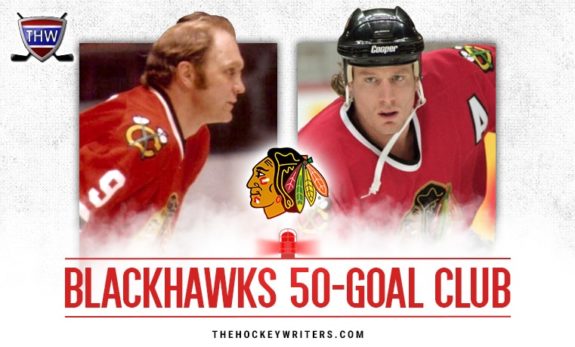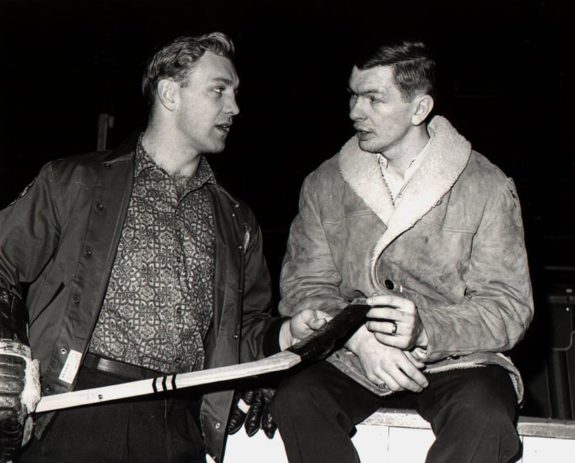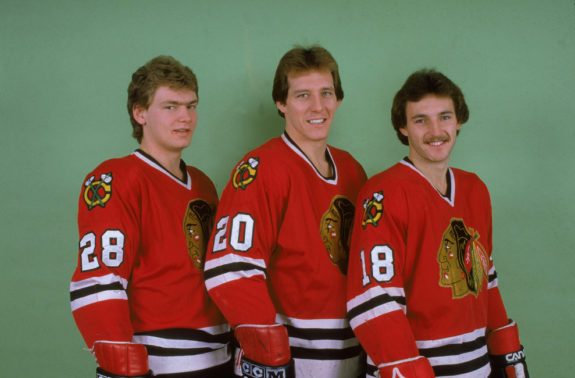Since their founding in 1926, the Chicago Blackhawks (and Black Hawks) have won six Stanley Cup championships. They’re one of the “Original Six” NHL teams along with the Detroit Red Wings, Montreal Canadiens, Toronto Maple Leafs, Boston Bruins and New York Rangers.

From Bobby Hull, Stan Mikita and Denis Savard to modern day players Patrick Kane and Jonathan Toews, the franchise has had more than their share of great hockey players. But only three of them have joined the NHL’s elite 50-goal club.
Bobby Hull
Five-Time Member of the NHL’s 50-Goal Club
Scored 50 goals in 70 games during the 1961-62 season.
Scored 54 goals in 65 games during the 1965-66 season.
Scored 52 goals in 66 games during the 1966-67 season.
Scored 58 goals in 74 games during the 1968-69 season.
Scored 50 goals in 78 games during the 1971-72 season.
Bobby Hull was one of the biggest superstars to play for the Blackhawks and one of the greatest players to ever play in the NHL. He was known as “The Golden Jet” for his explosive speed and flowing blonde hair during end-to-end rushes. His wrist shot was claimed to be harder than his blistering slap shot, which was once clocked at 118.3 mph. A prolific goal scorer and pound-for-pound one of the strongest and most powerful players in the league, Hull reached the 50-goal mark nine times in his 20-year career. Of these, five seasons were with the Blackhawks.
Prior to Hull arriving in Chicago, the franchise had missed the playoffs 11 out of the previous 12 seasons. Frustration and misery hung in the air like a foggy morning. Hull and his teammate Stan Mikita changed all of that. In his first season with the team, 1960-61, they won the Stanley Cup for the first time since 1938.
Hull’s first 50-goal feat occurred during the 1961-62 season, when he became the first Blackhawk player to ever do so. Injuries sidelined Hull for nine games in 1964-65, yet the Golden Jet scored 39 goals and helped Hawks reach the Stanley Cup Final. He won the Hart and Lady Byng Trophies. He followed that up by setting an NHL record by lighting the lamp 54 times and adding another Hart Trophy to his resume in 1965-66. He became the first player in NHL history with more than 50 goals in a single season as both Maurice Richard and Bernie “Boom Boom” Geoffrion had topped out at 50 goals in each of their respective seasons.
When Hull lit the lamp for his 51st goal, a game against the New York Rangers in Chicago Stadium, fans gave him a seven-minute standing ovation. He topped out at 54 goals for the season, a record for the Original Six era. He also set the record for most points in a season with 97, besting Dickie Moore’s 96 points in 1958-59, although it was broken the following year by Stan Mikita.
In 1966-67, Hull lifted the Hawks to its first regular-season championship since coach Pete Muldoon cursed the team after he was fired in 1938. He poured in 52 goals.
Hull’s 58-goal season in 1968-69 and 107 points weren’t enough to carry the Hawks into the playoffs. The 58-goal total was thought by many to last a long time. It didn’t – Boston Bruin Phil Esposito shattered it by scoring 76 goals just two years later. In 1971-72, Hull reached the 50-goal mark for the fifth time in Chicago. It was only one time less than all other players in NHL history combined up until that point in time.
Related: Toronto Maple Leafs’ 50-Goal Scorers
During Hull’s 23-year career in the NHL and WHA, he wore uniforms for the Black Hawks, Winnipeg Jets and Hartford Whalers. He originally wore No. 16 and No. 7 as a Black Hawk, but later switched to his famous No. 9, paying tribute to his childhood idol, Gordie Howe. He finished his career with one Stanley Cup (1961), three Art Ross Trophies, two Hart Memorial Trophies (as the NHL’s most valuable player) and 12 All-Star Game appearances. He led the NHL in goals seven times–more than any player in history (tied by Alexander Ovechkin in 2017–18). He retired with 610 goals in 1,063 regular-season games.

In his 15 full NHL seasons, he was voted the First-Team All-Star left winger ten times and the Second-Team All-Star left winger twice. He was elected to the Hockey Hall of Fame in 1983 and named one of the 100 Greatest NHL Players.
Bobby Hull Rule
In the 1960s, Hull and Mikita were catalysts for a craze where players curved the blades of their hockey sticks. The ‘banana blades’ became widely popular because they added velocity while making the puck’s trajectory unpredictable. Shooters loved it. Goalies hated it. It was especially dangerous for netminders since they did not wear masks back then. In 1970, a rule was put in place to limit the blade curvature to between one-half and three-quarters of an inch. The rule was later set to one-half inch.
Al Secord
Member of the NHL’s 50-Goal Club
Scored 54 goals in 80 games during the 1982-83 season.
The Boston Bruins selected Al Secord with the 16th overall pick in the first round of the 1978 Amateur Draft. As a 20-year-old, he began his career with the Bruins but was traded to Chicago in the middle of his third season. Wearing No. 20, Secord was a prototypical power forward–a rare breed of skill and toughness and was a consistent point producer.
In the 1981-82 season, Secord broke out, netting 44 goals. He was as feared for his shot as his fists, having racked up 303 penalty minutes. It made him the only player in NHL history to record 40 goals and 300 penalty minutes in a single season. He had two other seasons with more than 200 minutes.

In 1982-83, Secord became the second Blackhawks player in franchise history to join the 50-goal club. He posted a career-high 54 goals and 32 points. Of his 54 tallies, 34 were at even strength, while 20 came with the man advantage. Six goals were game winners.
Through his 766 NHL-game career, Secord scored 273 goals and 223 assists for 496 points. He amassed 2,093 career penalty minutes.
Jeremy Roenick
Two-time Member of the NHL’s 50-Goal Club
Scored 53 goals in 80 games during the 1991-92 season.
Scored 50 goals in 84 games during the 1992-93 season.
Jeremy Roenick was a feisty, sandpaper type of hockey player with talent and skill. Early on in the QMJHL, he registered a whopping 70 points in 28 games. No wonder the Blackhawks chose him with the eighth overall pick at the 1988 Entry Draft.
He enjoyed an 18-year career in the NHL, playing for the Blackhawks, Phoenix Coyotes, Philadelphia Flyers, Los Angeles Kings and San Jose Sharks. His success in his first few years gave the team’s management enough confidence that they traded forward Denis Savard for Chris Chelios in June 1990. They went on to win the Presidents’ Trophy in 1990-91.
The following year, Roenick broke out with 53 goals, 50 assists and 103 points, leading the team in scoring. They advanced to the Stanley Cup Final by defeating the Blues in six games and sweeping the Detroit Red Wings and Edmonton Oilers, before falling to the Pittsburgh Penguins in a four-game sweep. Of his 53 goals, 28 came at even strength, 22 came on with the man advantage and three were shorties. Thirteen were game-winning goals.
Related: Montreal Canadiens 50-Goal Scorers
Both feisty and productive, Roenick continued to fill the net in 1992-93, putting up 50 goals and 107 points. Again, merely half of his goals (22 of 50) came on the power play.
He nearly reached the 50-goal plateau for a third time in 1993-94, scoring 46 goals.
Roenick was the third American-born player to score 500 goals in his career (the others were Joe Mullen and Mike Modano). He retired in 2009 after scoring 513 goals (now ranking fourth behind Brett Hull, Modano and Keith Tkachuck) and accumulated more than 1,200 points.
The Almost-50 Goal Club
Patrick Kane scored a career-high 46 goals in 2015-16. He was the first Blackhawks player to reach the 40-goal plateau since Tony Amonte in 1999-00. Alex DeBrincat reached 41 in the 2018-19 season.
